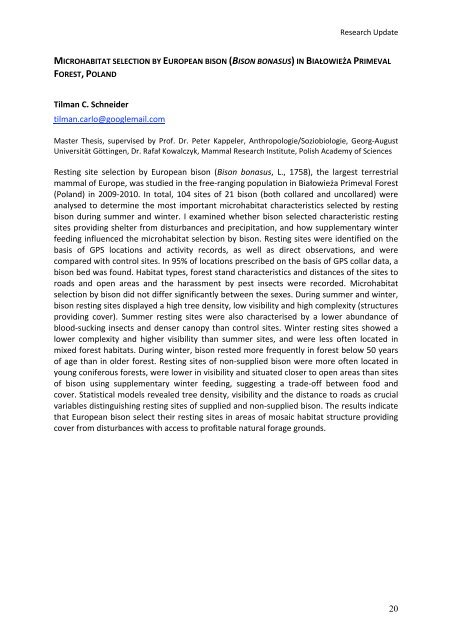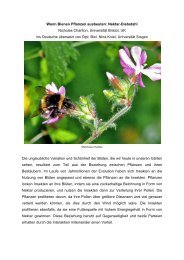PhDâ€theses - Ethologische Gesellschaft
PhDâ€theses - Ethologische Gesellschaft
PhDâ€theses - Ethologische Gesellschaft
Create successful ePaper yourself
Turn your PDF publications into a flip-book with our unique Google optimized e-Paper software.
Research Update<br />
MICROHABITAT SELECTION BY EUROPEAN BISON (BISON BONASUS) IN BIAŁOWIEŻA PRIMEVAL<br />
FOREST, POLAND<br />
Tilman C. Schneider<br />
tilman.carlo@googlemail.com<br />
Master Thesis, supervised by Prof. Dr. Peter Kappeler, Anthropologie/Soziobiologie, Georg‐August<br />
Universität Göttingen, Dr. Rafał Kowalczyk, Mammal Research Institute, Polish Academy of Sciences<br />
Resting site selection by European bison (Bison bonasus, L., 1758), the largest terrestrial<br />
mammal of Europe, was studied in the free‐ranging population in Białowieża Primeval Forest<br />
(Poland) in 2009‐2010. In total, 104 sites of 21 bison (both collared and uncollared) were<br />
analysed to determine the most important microhabitat characteristics selected by resting<br />
bison during summer and winter. I examined whether bison selected characteristic resting<br />
sites providing shelter from disturbances and precipitation, and how supplementary winter<br />
feeding influenced the microhabitat selection by bison. Resting sites were identified on the<br />
basis of GPS locations and activity records, as well as direct observations, and were<br />
compared with control sites. In 95% of locations prescribed on the basis of GPS collar data, a<br />
bison bed was found. Habitat types, forest stand characteristics and distances of the sites to<br />
roads and open areas and the harassment by pest insects were recorded. Microhabitat<br />
selection by bison did not differ significantly between the sexes. During summer and winter,<br />
bison resting sites displayed a high tree density, low visibility and high complexity (structures<br />
providing cover). Summer resting sites were also characterised by a lower abundance of<br />
blood‐sucking insects and denser canopy than control sites. Winter resting sites showed a<br />
lower complexity and higher visibility than summer sites, and were less often located in<br />
mixed forest habitats. During winter, bison rested more frequently in forest below 50 years<br />
of age than in older forest. Resting sites of non‐supplied bison were more often located in<br />
young coniferous forests, were lower in visibility and situated closer to open areas than sites<br />
of bison using supplementary winter feeding, suggesting a trade‐off between food and<br />
cover. Statistical models revealed tree density, visibility and the distance to roads as crucial<br />
variables distinguishing resting sites of supplied and non‐supplied bison. The results indicate<br />
that European bison select their resting sites in areas of mosaic habitat structure providing<br />
cover from disturbances with access to profitable natural forage grounds.<br />
20



